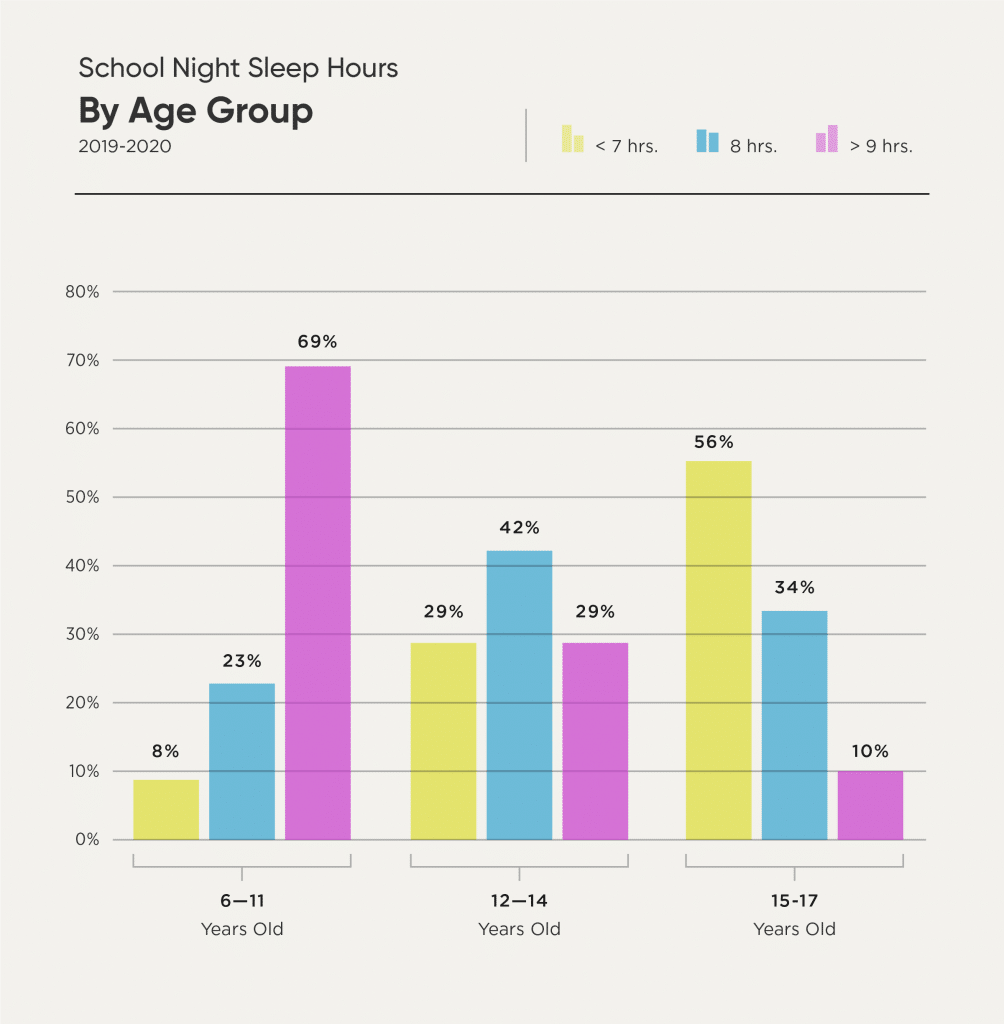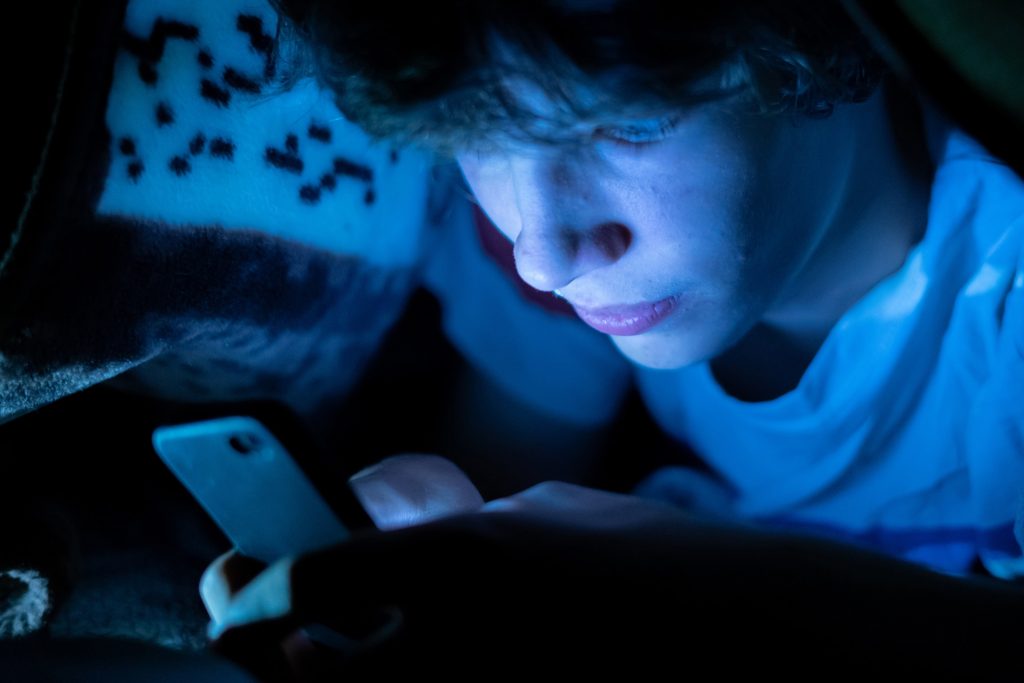No matter how old you are, sleep is a fundamental physiological process. But for children, getting quality sleep is even more vital as they progress through the stages of growth and development. Sleep disturbance and sleep disorders among children and adolescents have become more common in the digital age—one that can affect nearly every aspect of their lives. The rate of insomnia among adolescents is as high as 24%, and sleep disturbance is reported in children as early as infancy (Donskoy, 2018). According to the National Sleep Foundation, as children get older, sleep duration decreases to 7 hours or less per night despite the appropriate range for teenagers being anywhere from 8-10 hours (National Sleep Foundation, 2014; Suni, 2020).

While sleep is impacted by many environmental, biological, genetic, and social factors, technology is one that parents can more readily isolate and address. Not only can electronics disrupt sleep by emitting sound and light, but devices are frequently used as distractions that keep children awake longer. A recent research study emphasizes the importance of parental influence on children’s sleep habits, especially teaching children how to adjust to their changing sleep needs as they grow (Godsell, 2019). Essentially, parents can improve their child’s sleep quality by helping them make manageable changes so that they are successful and healthy.
Girls report heavy social media use at night and claim to feel pressure to be constantly active and responsive online.
—Sarah Godsell, South Gloucestershire Council, Yate, United Kingdom
Electronics Are Disrupting Sleep
Blue light

Blue light exposure can reduce feelings of sleepiness before bedtime and keep you more awake during the night (Shechter, 2019). Electronic devices, as well as many domestic light bulbs, emit blue light with this effect. The body naturally creates a need for sleep that aligns with our biological clock (Johansson, 2017). This causes us to sleep when it is dark and be awake when it is bright, our bodies producing increased melatonin as a signal that it’s time to go to bed. When exposed to prolonged periods of light through late-night electronic use, a child’s biological clock believes it is still daytime and delays melatonin production. Using a device at bedtime is a major contributing factor in taking a long time to fall asleep (Shechter, 2019).
Late-night scrolling distractions
A staggering 89% of adults and 75% of children have at least one electronic device in their bedroom.
—National Institutes of Health
Not only does light emitted from screens cause sleep complications, but so does the habit of using technology as a way to decompress before bed. Counterintuitively, screen use makes it more difficult to fall asleep because of continued stimulation (Johansson, 2017). According to The National Institutes of Health, nearly “three-fourths of American children and adolescents report the presence of at least one screen-media device in their bedroom, with roughly 60% reporting regular use of these devices during the hour before bedtime (Hale et al., 2018). This can become problematic because it leaves the child unmonitored and free to use their electronics for however long they want. One study showed that some adolescents even use an average of four devices at once after 9:00 pm (Johansson, 2017).
It’s important to trust your children with new responsibilities as they mature, such as self-managing their bedtime behaviors. However, as research repeatedly shows, if there are no established boundaries around device usage, children will not know when to turn them off and sleep.
Parental intervention is necessary for establishing a healthy bedtime routine because young people will often ignore the risks of sleep deprivation in favor of continued technology use. Researchers have found that many adolescents are emotionally attached to their phones, either seeking validation from their peers or being motivated by fear of missing out. Boys were more likely to spend their time before bed streaming movies and TV shows and playing video games as a way to connect with their peers online. On the other hand, girls reported heavy social media use at night. They claim to feel pressure to be constantly active and responsive online. Girls also expressed concerns about societal expectations to look attractive, which often kept them up at night or resulted in waking up earlier than normal to get ready for the day (Godsell, 2019).
These motivations are concerning enough, but combining them with the resulting sleep deprivation could begin to have serious effects on a child’s quality of life. Having a conversation with your child about their device usage at night is a solid first step in learning about their concerns and how to help them.
Negative Effects of Sleep Deprivation on Children
Young children and teens face a monumental task: not only are they gaining knowledge and skills in school but also learning how their bodies and minds work. Emerging evidence suggests that sleep plays a critical role in childhood brain development, which means they need quality sleep to perform at their cognitive best. One study reported that even small sleep disturbances harmed cognition. When a child doesn’t get enough sleep, they can’t stay focused, follow directions, adapt to new situations, show self-control, process emotions, learn new information, or form memories (Tarokh, 2016). This can affect their academic, social, and workplace performances and limit their opportunities for engagement and activity.

Additionally, while sleep deprivation may not always be the direct cause of many physical and mental health conditions, it can certainly exacerbate them. Sleep deprivation puts children at risk of obesity, a compromised immune system, anxiety, depression, mood swings, fatigue, poor judgment, and lowered impulse control (Godsell, 2019; Johannson, 2016; Tarokh, 2016).
Many adolescents have also shown an increase in risk-taking behaviors that could be dangerous to themselves and others. This behavior could include anything from driving while drowsy to drunk driving, both of which link to an increase in car accidents involving adolescent drivers (Johansson, 2016). Sleep deprivation is a big problem for kids and teens. But the good news is that they can correct their sleep habits and improve their quality of life.
So, How Can You Help Your Child?
Making sleep a priority for children and establishing a strong sleep hygiene routine is the first step to improving their sleep quality. Start by having an honest and open conversation with your child about any sleep struggles they may be experiencing. Share with them what you have observed and ask them what they have noticed. As your kids mature and gain independence, they often won’t tell you if they’re struggling; they might avoid seeking help to escape embarrassment (Donskoy, 2018). Thus, you might be better off starting this conversation yourself rather than waiting for your kids to come to you first.

This conversation should focus on assessing your child’s current perceptions of their sleeping habits and needs. One study found that many adolescents lack the knowledge of what healthy sleep should look like and thus fail to recognize their problematic behaviors. Some teenage participants in this study expressed that the amount of sleep someone needs is subjective. They believe some people can function better with less sleep. Other participants assumed that being tired was a universal experience (Godsell, 2019), suggesting that they have simply adjusted to their anticipated drowsiness. Keeping an eye out for these types of red flags can help parents correct any skewed perceptions their children may have of sleep.
Households with consistently enforced bedtime routines saw their children sleep about 1.1 hours longer than households with no bedtime routines.
—National Sleep Foundation, 2014
Finally, the discussion should include a collaborative effort between you and your child to establish boundaries and rules regarding a bedtime routine. Having these kinds of restrictions may irritate your child, but setting and maintaining boundaries is the only way to establish positive, long-lasting sleep habits. The National Sleep Foundation found that in households with bedtime routines consistently enforced, children slept about 1.1 hours longer than households with no bedtime routines (2014).
Work together with your child to create a bedtime routine that is reasonable and realistic so that it will work with busy life schedules. The CDC, the National Sleep Foundation, and the American Sleep Association provide excellent tips and resources that you can reference when building a sleep hygiene routine with your family.
Ideas for Discussion
- How would you like to feel when your alarm wakes you up?
- Did you know that a lack of sleep can slow down a person’s reflexes? When might you need to be quick-thinking and quick-acting?
- How is your energy level throughout the day? Is it pretty consistent? Do you ever feel like you’ve “hit a wall”?
- What makes a good night’s sleep? What do you notice about your bedtime habits?
- How do you feel about setting boundaries around using electronics at night? What concerns do you have?
References
- Donskoy, I., & Loghmanee, D. (2018). Insomnia in adolescence. Medical Sciences, 6(3). https://doi.org/10.3390/medsci6030072
- Godsell, S., & White, J. (2019). Adolescent perceptions of sleep and influences on sleep behaviour: A qualitative study. Journal of Adolescence, 73. https://doi.org/10.1016/j.adolescence.2019.03.010
- Hale, L., Kirschen, G. W., LeBourgeois, M. K., Gradisar, M., Garrison, M. M., Montgomery-Downs, H., Kirschen, H., McHale, S. M., Chang, A.-M., & Buxton, O. M. (2018, April). Youth screen media habits and sleep: sleep-friendly screen-behavior recommendations for clinicians, educators, and parents. Child and adolescent psychiatric clinics of North America. Retrieved September 22, 2021, from https://www.ncbi.nlm.nih.gov/pmc/articles/PMC5839336/
- Johansson, A. E. E., Petrisko, M. A., & Chasens, E. R. (2016). Adolescent sleep and the impact of technology use before sleep on daytime function. Journal of Pediatric Nursing, 31(5). https://doi.org/10.1016/j.pedn.2016.04.004
- National Sleep Foundation. (2014). 2014 sleep in the modern family. Sleep Foundation. Retrieved September 18, 2021, from https://www.sleepfoundation.org/professionals/sleep-americar-polls/2014-sleep-modern-family
- Shechter, A., Kim, E. W., St-Onge, M.-P., & Westwood, A. J. (2017). Blocking nocturnal blue light for insomnia: A randomized controlled trial. Journal of Psychiatric Research, 96. https://doi.org/10.1016/j.jpsychires.2017.10.015
- Suni, E. (2020, August 5). Teens and Sleep. Sleep Foundation. Retrieved September 16, 2021, from https://www.sleepfoundation.org/teens-and-sleep
- Tarokh, L., Saletin, J. M., & Carskadon, M. A. (2016). Sleep in adolescence: Physiology, cognition and mental health. Neuroscience & Biobehavioral Reviews, 70. https://doi.org/10.1016/j.neubiorev.2016.08.008









Success!
Your comment has been submitted for review! We will notify you when it has been approved and posted!
Thank you!